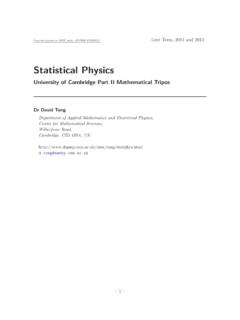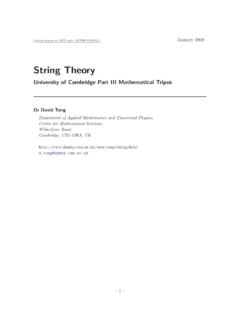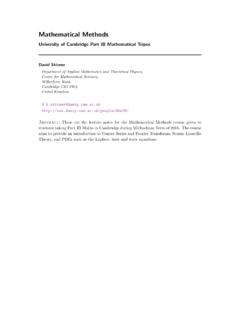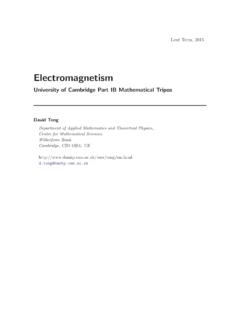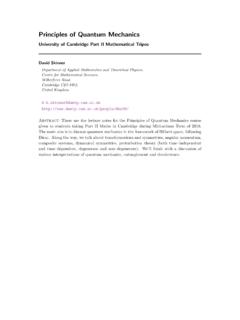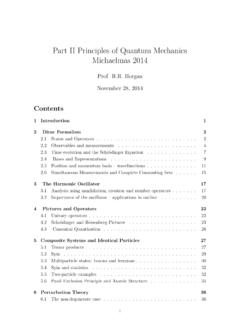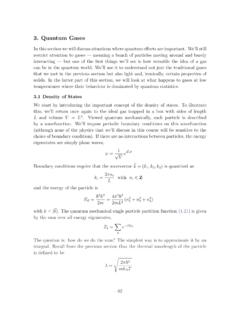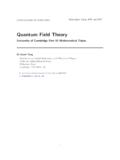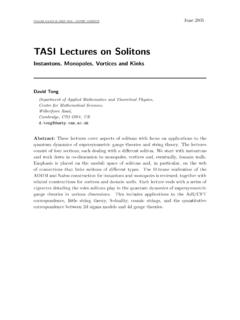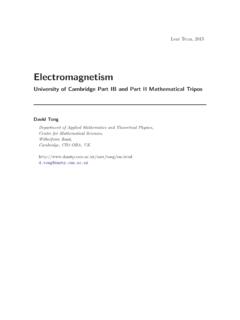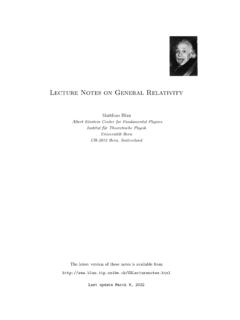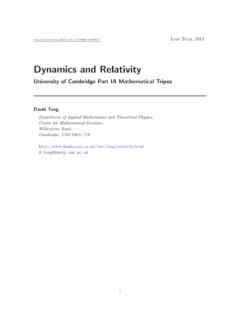Transcription of 4. Central Forces - University of Cambridge
1 4. Central ForcesIn this section we will study the three-dimensional motion of a particle in a centralforce potential. Such a system obeys the equation of motionm x= rV(r)( )where the potential depends only onr=|x|.Sincebothgravitationalandelectro staticforces are of this form, solutions to this equation contain some of the most importantresults in classical first line of attack in solving ( ) defined asL=mx xWe already saw in angular momentum is conserved in a centralpotential. The proof is straightforward:dLdt=mx x= x rV=0where the final equality follows becauserVis parallel conservation of angular momentum has an important consequence: all motiontakes place in a plane. This follows becauseLis a fixed, unchanging vector which, byconstruction, obeysL x=0So the position of the particle always lies in a plane perpendicular ,L x=0sothevelocityoftheparticlealsoliesint hesameplane.
2 Inthisway the three-dimensional dynamics is reduced to dynamics on a Polar Coordinates in the PlaneWe ve learned that the motion lies in a plane. It will turn out to be much easier if wework with polar coordinates on the plane rather than Cartesian coordinates. For thisreason, we take a brief detour to explain some relevant aspects of polar start, we rotate our coordinate system so that the angular momentum points inthez-direction and all motion takes place in the (x,y) coordinatesx=rcos ,y=rsin 48 Our goal is to express both the velocity and acceleration^r^ xyFigure 11:in polar coordinates. We introduce two unit vectors, rand in the direction of increasingrand respectivelyas shown in the diagram. Written in Cartesian form,these vectors are r= cos sin !
3 , = sin cos !These vectors form an orthornormal basis at every pointon the plane. But the basis itself depends on which angle we sit at. Moving in theradial direction doesn t change the basis, but moving in the angular direction we haved rd = sin cos != ,d d = cos sin != rThis means that if the particle moves in a way such that changes with time, then thebasis vectors themselves will also change with time. Let s see what this means for thevelocity expressed in these polar coordinates. The position of a particle is written asthe simple, if somewhat ugly, equationx=r rFrom this we can compute the velocity, remembering that bothrand the basis vector rcan change with time. We get x= r r+rd rd = r r+r ( )The second term in the above expression arises because the basis vectors change withtime and is proportional to theangular velocity.
4 (Strictlyspeaking,thisistheangularspeed. In the next section, we will introduce a vector quantity which is the angularvelocity).Di erentiating once more gives us the expression for acceleration in polar coordinates, x= r r+ rd rd + r +r +r d d =( r r 2) r+(r +2 r ) ( )The two expressions ( )and( )willbeimportantinwhatfollows. 49 An Example: Circular MotionLet s look at an example that we re already all familiar with. A particle moving in acircle has r=0. Iftheparticletravelswithconstantangularv elocity =!then thevelocity in the plane is x=r! so the speed in the plane inv=| x|=r!.Similarly,theaccelerationintheplan eis x= r!2 rThe magnitude of the acceleration isa=| x|=r!2=v2/r. From Newton s secondlaw, if we want a particle to travel in a circle, we need to supply a forceF=mv2/rtowards the origin.
5 This is known as acentripetal Back to Central ForcesWe ve already seen that the three-dimensional motion in a Central force potential ac-tually takes place in a plane. Let s write the equation of motion ( )usingtheplanepolar coordinates that we ve just introduced. SinceV=V(r), the force itself can bewritten usingrV=dVdr rand, from ( )theequationofmotionbecomesm( r r 2) r+m(r +2 r ) = dVdr r( )The component of this is particularly simple. It isr +2 r =0)1rddt r2 =0It looks as if we ve found a new conserved quantity since we ve learnt thatl=r2 ( )does not change with time. However, we shouldn t get too excited. This is somethingthat we already know. To see this, let s look again at the angular used the fact that the direction ofLis conserved when restricting motion tothe plane.
6 But what about the magnitude ofL? Using ( ), we writeL=mx x=mr r r r+r =mr2 r 50 Since rand are orthogonal, unit vectors, r is also a unit vector. The magnitudeof the angular momentum vector is therefore|L|=mlandl,givenin( ), is identified as the angular momentum per unit mass, althoughwe will often be lazy and refer tolsimply as the angular s now look at the rcomponent of the equation of motion ( ). It ism( r r 2)= dVdrUsing the fact thatl=r2 is conserved, we can write this asm r= dVdr+ml2r3( )It s worth pausing to reflect on what s happened here. We started in ( )withacom-plicated, three dimensional problem. We used the direction of the angular momentumto reduce it to a two dimensional problem, and the magnitude of the angular momen-tum to reduce it to a one dimensional problem.
7 This was all possible because angularmomentum is should give you some idea of how important conserved quantities are when itcomes to solving anything. Roughly speaking, this is also why it s not usually possibleto solve theN-body problem withN 3. In ,we llseethatfortheN=2mutually interacting particles, we can use the symmetry of translational invariance tosolve the problem. But forN 3, we don t have any more conserved quantities tocome to our to our main storyline, we can write ( )inthesuggestiveformm r= dVe dr( )whereVe (r)iscalledthee ective potentialand is given byVe (r)=V(r)+ml22r2( )The extra term,ml2/2r2is called theangular momentum barrier(also known as thecentrifugal barrier). It stops the particle getting too close to the origin, since there ismust pay a heavy price in e ective energy.
8 51 VeffrEminr*Figure 12:The e ective potential arising from the inverse square force The E ective Potential: Getting a Feel for OrbitsLet s just check that the e ective potential can indeed be thought of as part of theenergy of the full system. Using ( ), we can write the energy of the full three dimen-sional problem asE=12m x x+V(r)=12m r2+12mr2 2+V(r)=12m r2+ml22r2+V(r)=12m r2+Ve (r)This tells us that the energyEof the three dimensional system does indeed coincidewith the energy of the e ective one dimensional system that we ve reduced to. Thee ective potential energy is the real potential energy, together with a contribution fromthe angular kinetic already saw in we can understand qualitative aspects of onedimensional motion simply by plotting the potential energy.
9 Let s play the same gamehere. We start with the most useful example of a Central potential:V(r)= k/r,corresponding to an attractive inverse square law fork>0. The e ective potential isVe = kr+ml22r2and is drawn in the figure. 52 The minimum of the e ective potential occurs atr?=ml2/kand takes the valueVe (r?)= k2 E=Emin= k2/2ml2: Here the particle sits at the bottom of the wellr?andstays there for all time. However, remember that the particle also has angularvelocity, given by =l/r2?.Soalthoughtheparticlehasfixedradi alposition,itis moving in the angular direction. In other words, the trajectory of the particleis a circular orbit about the that the radial position of the minimum depends on the angular mo-mentuml. The higher the angular momentum, the further away the there is no angular momentum, andl=0,thenVe =Vand the potential hasno minimum.
10 This is telling us the obvious fact that there is no way thatrcanbe constant unless the particle is moving in the direction. In a similar vein,notice that there is a relationship between the angular velocity and the size ofthe orbit,r?,whichwegetbyeliminatingl:itis 2=k/mr3?. We ll come backto this relationship in we discuss Kepler s laws of planetarymotion. Emin<E<0: Here the 1d system sits in the dip, oscillating backwards andforwards between two points. Of course, sincel6=0,theparticlealsohasangularveloc ity in the plane. This describes an orbit in which the radial distancerdepends on time. Although it is not yet obvious, we will soon show that forV= k/r, smallest value ofrthat the particle reaches is called distance is called ,thesetwopointsarereferredto as ,theperiapsisiscalledtheperihelionand the apoapsis theaphelion.
